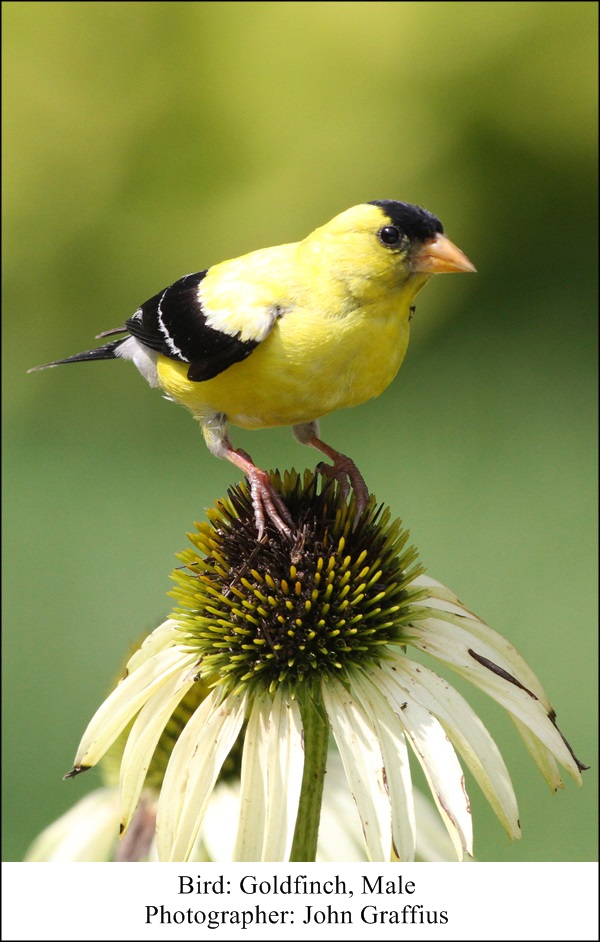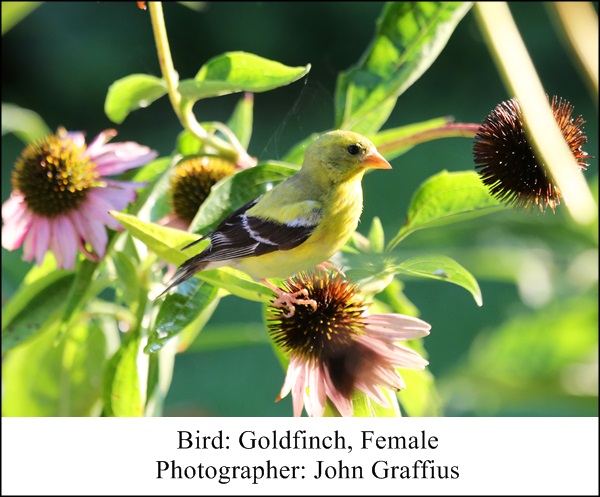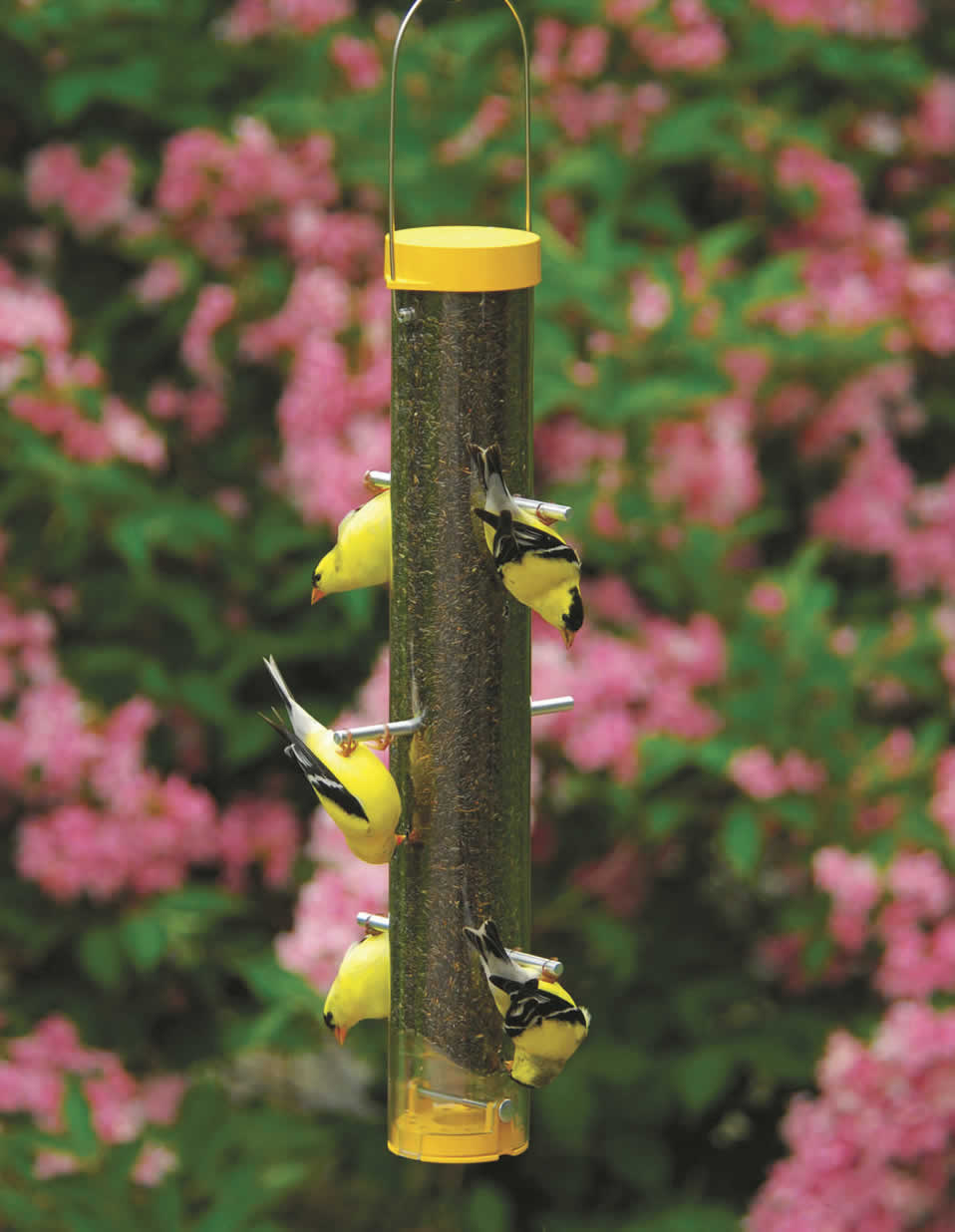The American Goldfinch remains one of the most beloved birds at our feeders. With their bright yellow color, their dainty behavior and uplifting song, their popularity is understandable.
Their flight pattern is distinctive as well; bouncy and undulating, often accompanied by their flight call which sounds as if they are saying “perchickaree” or “potato chip”.
Often referred to as Wild Canaries, these birds can be easily attracted to your yard with their favorite plants as well as bird feeders. The Goldfinches’ natural habitats are weedy fields and floodplains.
Goldfinches are not an aggressive bird in their feeding areas, both natural and at your feeders. Giving them a space where their feeder is not as close to others will decrease the chances of them being chased away. Goldfinches will eat both nyjer (thistle) and sunflower seeds. A combination of both sunflower and nyjer (thistle) seed is a great way to satisfy their need for fat and protein.
American Goldfinches are the only finch that molts their feathers twice per year. March is the time to look for the males to appear with sporadic bright yellow feathers replacing their khaki camouflage feathers. Goldfinches will also grow new tail and wing feathers, unlike many birds that molt feathers with the exception of those two areas. Creating these additional feathers requires a great deal of food and energy, with the molt taking six weeks to complete. This explains why they may use feeders so heavily in the Spring as a supplement to natural foods.
Nesting soon after the monumental physical change of molt would be additionally draining, and is the reason that Goldfinches nest in late June and July. The female selects the nest site, builds the nest, lays the eggs, and incubates without the help of the male.
Constructed of small grasses and soft, downy material, the base of the nest is attached to the twigs with spider webs for strength. The average clutch size is five eggs which are incubated for twelve days. The fledgling period that the chicks spend in the nest while being fed by their parents is also around twelve days.
Young goldfinches are one of the few birds that are fed a diet of seeds only, with no protein in the form of insects. Young goldfinches are very vocal in their efforts to be fed. Listen to the birds in your yard and you will hear the babies chiming out their “chippee, chippee” quite regularly.
If House Sparrows with their large flock numbers are becoming a challenge to your Goldfinches, try using the feeders designed for the Goldfinches to feed upside down. A goldfinches’ body is built so that they can readily adapt to feeding upside down, something which is more challenging for House Sparrows. You can further make your finch feeders more sparrow-resistant by trimming the perches down to one inch.
Having a total seed diet creates a real thirst in these birds. A birdbath with a shallow area gives goldfinches the ability to bathe at a depth that they can handle. Placing a few rocks inside your birdbath to copy a natural streamside setting is a perfect way to entice Goldfinches. Clean, fresh water is essential to the birds’ health; therefore, a daily brushing, rinse, and refill of the birdbath is your best strategy.
Creating a garden for Goldfinches is easy. The seeds of plants in the Asteraceae (Compositae) family area a sure bet. Try Black-eyed Susan (Rudbeckia Hirta), Purple Coneflower (Echinacea purpurea), Joe Pye Weed (Eutrochium), Cutleaf Coneflowers (Rudbeckia laciniata), and Cup Plant (Silphium perfoliatum). A favorite in my yard is Woodland Sunflower (Helianthus divaricatus) – sometimes I can count a dozen of these golden beauties mixed in with the equally bright flowers.
Native thistle is very attractive to Goldfinches not only for a food source – the down of the plant is used as a lining for their nest. Try Field Thistle (Cirsium discolor), Flogman’s thistle (Cirsium flodmanii) and Wavyleaf Thistle (Cirsium undulatum).
Enjoy the beauty that Goldfinches add to your yard.
Enjoy your birds!
Have you joined our email list? Click here to sign up, it’s free and gives you access to sales, coupons, nature news, events, and more!



